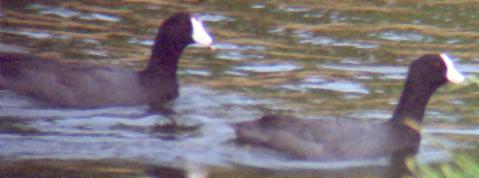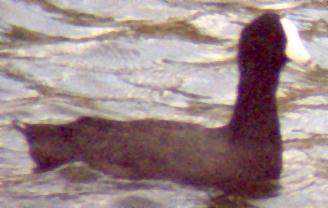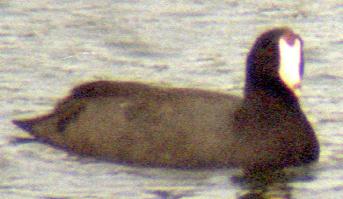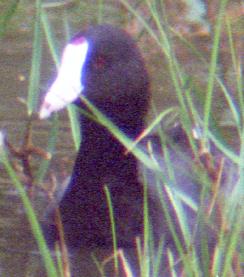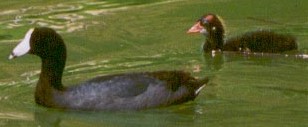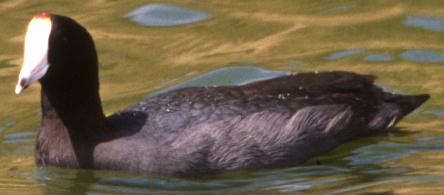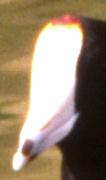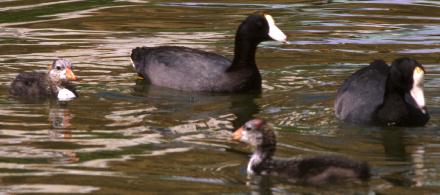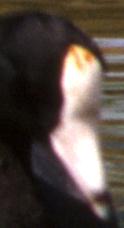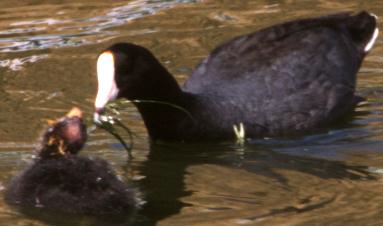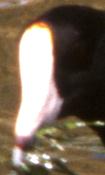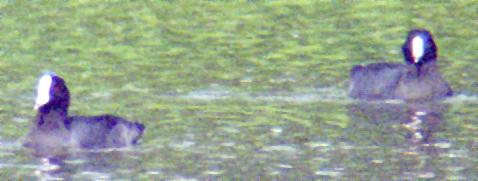The American Coot breeds from North America south to
northwestern South America and, in recent years, has been documented
breeding in the Greater Antilles and northern Lesser Antilles south to
Guadeloupe, where it appears to be expanding its range. The Caribbean
Coot breeds in the Greater Antilles, Lesser Antilles, Curacao and
western Venezuela. The two forms are currently regarded as specifically
distinct but reports of mixed pairs and intermediate individuals in the
northern Caribbean suggest that they may be conspecific. The degree of
clinal variation and assortative mating has not been thoroughly
investigated. The variability of these taxa, which has been discussed
by Clark (1985) and more thoroughly by Roberson and Baptista (1988), is
discussed in this photo essay.
Coots
possess a 'shield' that represents an extension of the maxilla onto the
forehead. The size and shape of the shield vary seasonally and is often
swollen in both sexes during the breeding season. In some species a
fleshy 'callus' represents an accessory atop the shield. American Coots
typically possess a small white shield extending to the eyes or halfway
between the eyes and crown, with a large reddish or brownish callus.
Caribbean Coots typically possess a large white shield extending to the
crown; the shield is sometimes tinged yellow and the callus is absent.
Thus, any coot with a red callus can be assumed to represent an
American Coot. However, up to 1.5% of American Coot males with high
testosterone levels possess a large frontal shield with a reduced
callus that may even be absent. Such individuals were intitially
thought to represent Caribbean Coots but are now regarded as variants
of American Coot (there are no satisfactory North American records of
Caribbean Coot) essentially indistinguishable from Caribbean Coot.
Thus, identification of white-shielded male coots in the potential
range of overlap is problematic. Males of both species average larger
than females. American Coots are proportionately longer winged and
shorter legged than Caribbean Coots, but much overlap occurs.
Intermediate appearing individuals possessing a large white shield with
a vestigial callus occur throughout North America, where hybridization
obviously does not occur. Whether or not such intermediate birds in the
northern Caribbean represent hybrids or variants within either taxon
remains uncertain. Such individuals should be documented even though
their specific identity may be uncertain.
Roberson and Baptista (1988) used the following categories for scoring shield type variation in coots:
A = normal American Coots with typical red callus
B = 'intermediates,' with red callus but washed with yellow on shield below callus, some having a very
reduced callus
C = bulbous shields strongly washed yellow, sometimes with reddish splotches
D = bulbous white shields, with obvious reddish spots, streaks, or splotches, but not a callus
E = bulbous white shields with little or no reddish staining, limited
(if present) to extreme upper edge of shield
(i.e., normal Caribbean Coot)
These categories should be adopted by observers of coots in the
Caribbean. Seemingly mixed pairs should be studied to determine the sex
of each individual, if possible. Males should be larger and mount
females. Both sexes participate in nest construction, incubation and
parental care.
LITERATURE CITED
Clark, C. T. 1985. Caribbean Coot? Birding 17:84-88.
Roberson, D., and L. F. Baptista. 1988. White-shielded coots in North America: a critical evaluation. American
Birds 42:1241-1246. |
